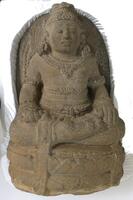33 UMMA Objects
33 UMMA Objects
![This stone dagger has a handle that is divided into two parts, separated from each other by a thinner band. The upper tier is smaller in length than the lower tier, which flares outward as it approaches the end. The tip of blade is broken off. In profile, the blade thickens in the center.<br />
<br />
Carved from stone, this dagger with a two-tier handle is missing only its tip. The cross section of the blade is rhomboid, while that of the handle is shaped like a convex lens. The dagger is of the later two-tier-handled type (<em>idanbyeongsik</em>), meaning that it probably dates from the end of the early Bronze Age or the beginning of the middle Bronze Age. Max Loehr (1903- 1988) was a German art historian specializing in East Asian art who taught at the University of Michigan from 1951 to 1960 as a professor.<br />
[Korean Collection, University of Michigan Museum of Art (2017) p.32] This stone dagger has a handle that is divided into two parts, separated from each other by a thinner band. The upper tier is smaller in length than the lower tier, which flares outward as it approaches the end. The tip of blade is broken off. In profile, the blade thickens in the center.<br />
<br />
Carved from stone, this dagger with a two-tier handle is missing only its tip. The cross section of the blade is rhomboid, while that of the handle is shaped like a convex lens. The dagger is of the later two-tier-handled type (<em>idanbyeongsik</em>), meaning that it probably dates from the end of the early Bronze Age or the beginning of the middle Bronze Age. Max Loehr (1903- 1988) was a German art historian specializing in East Asian art who taught at the University of Michigan from 1951 to 1960 as a professor.<br />
[Korean Collection, University of Michigan Museum of Art (2017) p.32]](/media/W1siZiIsIjIwMjIvMDUvMjUvMjhpaWV3MzJmbV9kZWZhdWx0LmpwZyJdLFsicCIsInRodW1iIiwiMjQweDIwMCJdXQ?sha=d2502c4cf43f3c8e)
Korean (Korean (culture or style))
Polished Stone Dagger
900 BCE – 701 BCE
Museum purchase from the collection of Max Loehr
1960/2.117

Chinese (Chinese (culture or style))
Mirror, "Marriage type" (with lobed rim and paired design motifs)
600 – 799
Museum purchase for the James Marshall Plumer Memorial Collection
1961/2.62
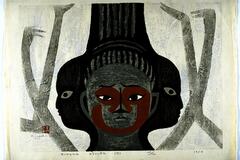
Saitō Kiyoshi (Japanese (culture or style))
Buddha Asyura (Ashura, Kôfukuji, Nara)
1959
Gift of Dr. Lawrence Preuss
1986/2.65
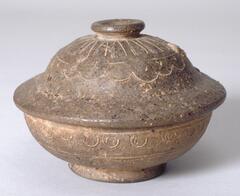
Korean (Korean (culture or style))
Cinerary urn with triangular circle-and-dot design
7th century
Gift of Mrs. Caroline I. Plumer for the James Marshall Plumer Collection
1973/2.36A&B
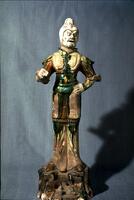
Chinese (Chinese (culture or style))
Warrior
667 – 732
Transfer from the College of Architecture and Design
1972/2.68
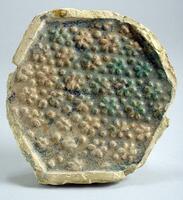
Iranian (Iranian)
Tile
8th century
Transfer from the School of Art and the College of Architecture and Urban Planning.
1997/1.255
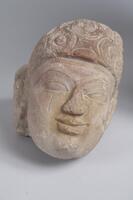
Indian (Indian (South Asian))
Bodhisattva (?), head
8th century
Gift of Mark and Iuliana Phillips
1996/2.31
![This stoneware vessel consists of a bowl and lid. The curved hemispheric lid has a ring-shaped knob in the center and is decorated a lot of dot line design. The hemispheric bowl stands on the low foot with a flat base. This part is also decorated with stamped design.<br />
<br />
This is a dark gray, high-fired stoneware lidded bowl decorated with a stamped design. A ring-shaped knob at the top of the lid is surrounded by vertically aligned dotted designs radiating outwards. The bowl rim is rounded, while two narrowly incised lines surround its widest part, located just below the lip of the rim where the lid rests. Below these lines, the body is stamped with a continuous, vertically aligned, horseshoe pattern. The short and broad horseshoe motif conveys a sense of stability.
<p>[Korean Collection, University of Michigan Museum of Art (2017) p. 78]</p>
This stoneware vessel consists of a bowl and lid. The curved hemispheric lid has a ring-shaped knob in the center and is decorated a lot of dot line design. The hemispheric bowl stands on the low foot with a flat base. This part is also decorated with stamped design.<br />
<br />
This is a dark gray, high-fired stoneware lidded bowl decorated with a stamped design. A ring-shaped knob at the top of the lid is surrounded by vertically aligned dotted designs radiating outwards. The bowl rim is rounded, while two narrowly incised lines surround its widest part, located just below the lip of the rim where the lid rests. Below these lines, the body is stamped with a continuous, vertically aligned, horseshoe pattern. The short and broad horseshoe motif conveys a sense of stability.
<p>[Korean Collection, University of Michigan Museum of Art (2017) p. 78]</p>](/media/W1siZiIsIjIwMjIvMDkvMjQvMjdlZTg4d3JyZF9kZWZhdWx0LmpwZyJdLFsicCIsInRodW1iIiwiMjQweDIwMCJdXQ?sha=2326346688ebc446)
Korean (Korean (culture or style))
Cinerary Urn or Reliquary with stamped "fish scale" designs
600 – 799
Gift of Bruce and Inta Hasenkamp and Museum purchase made possible by Elder and Mrs. Sang-Yong Nam
2004/1.204A&B
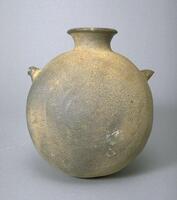
Japanese (Japanese (culture or style))
Water Canteen, Sue Ware
8th century
Gift of G. Nakajima, Kyoto, Japan
1986/2.11
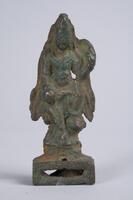
Chinese (Chinese (culture or style))
Bodhisattva, seated in lalitasana: part of a miniature shrine
600 – 799
Gift of Marybelle B. Hanna
2001/1.363
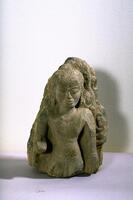
Khmer (Khmer (general))
Head and torso of a Bodhisattva (Srivijaya Style)
8th century
Gift of John Adams Thierry in memory of Louis Sidney Thierry
1993/2.36
Loading…
